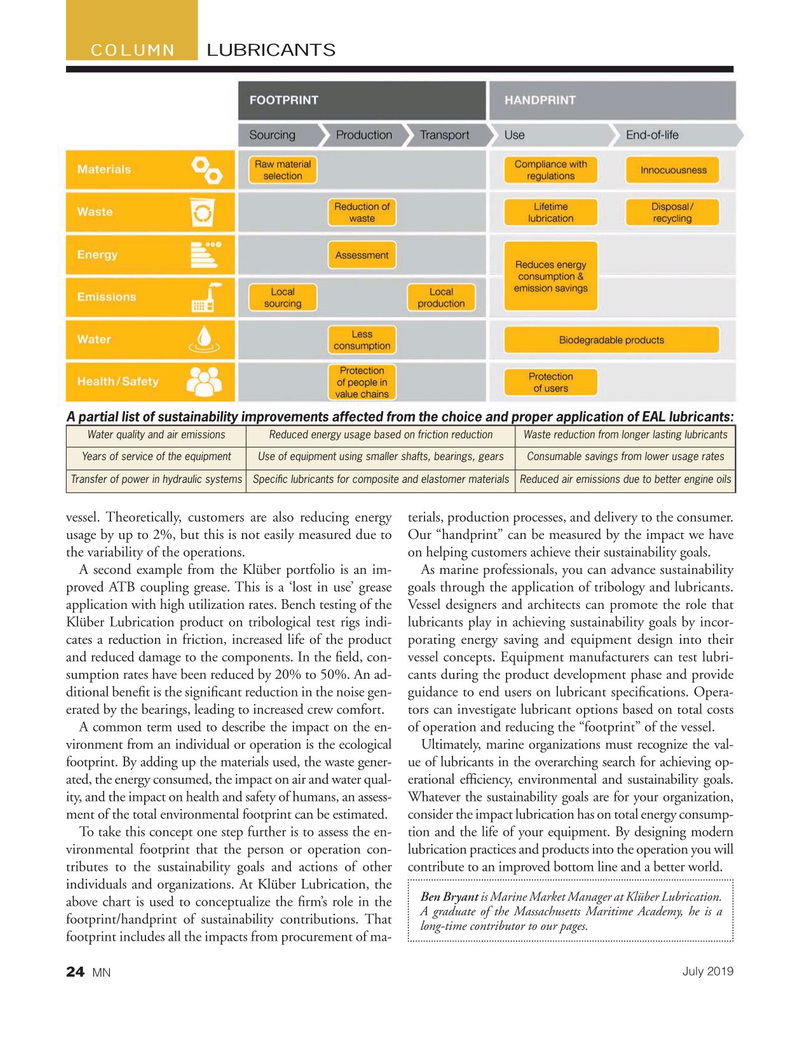
Page 24: of Marine News Magazine (July 2019)
Propulsion Technology
Read this page in Pdf, Flash or Html5 edition of July 2019 Marine News Magazine
COLUMN LUBRICANTS
A partial list of sustainability improvements affected from the choice and proper application of EAL lubricants:
Water quality and air emissionsReduced energy usage based on friction reductionWaste reduction from longer lasting lubricants
Years of service of the equipmentUse of equipment using smaller shafts, bearings, gearsConsumable savings from lower usage rates
Transfer of power in hydraulic systemsSpeci? c lubricants for composite and elastomer materialsReduced air emissions due to better engine oils vessel. Theoretically, customers are also reducing energy terials, production processes, and delivery to the consumer. usage by up to 2%, but this is not easily measured due to Our “handprint” can be measured by the impact we have the variability of the operations. on helping customers achieve their sustainability goals.
A second example from the Klüber portfolio is an im- As marine professionals, you can advance sustainability proved ATB coupling grease. This is a ‘lost in use’ grease goals through the application of tribology and lubricants. application with high utilization rates. Bench testing of the Vessel designers and architects can promote the role that
Klüber Lubrication product on tribological test rigs indi- lubricants play in achieving sustainability goals by incor- cates a reduction in friction, increased life of the product porating energy saving and equipment design into their and reduced damage to the components. In the ? eld, con- vessel concepts. Equipment manufacturers can test lubri- sumption rates have been reduced by 20% to 50%. An ad- cants during the product development phase and provide ditional bene? t is the signi? cant reduction in the noise gen- guidance to end users on lubricant speci? cations. Opera- erated by the bearings, leading to increased crew comfort. tors can investigate lubricant options based on total costs
A common term used to describe the impact on the en- of operation and reducing the “footprint” of the vessel.
vironment from an individual or operation is the ecological Ultimately, marine organizations must recognize the val- footprint. By adding up the materials used, the waste gener- ue of lubricants in the overarching search for achieving op- ated, the energy consumed, the impact on air and water qual- erational ef? ciency, environmental and sustainability goals. ity, and the impact on health and safety of humans, an assess- Whatever the sustainability goals are for your organization, ment of the total environmental footprint can be estimated. consider the impact lubrication has on total energy consump-
To take this concept one step further is to assess the en- tion and the life of your equipment. By designing modern vironmental footprint that the person or operation con- lubrication practices and products into the operation you will tributes to the sustainability goals and actions of other contribute to an improved bottom line and a better world. individuals and organizations. At Klüber Lubrication, the
Ben Bryant is Marine Market Manager at Klüber Lubrication. above chart is used to conceptualize the ? rm’s role in the
A graduate of the Massachusetts Maritime Academy, he is a footprint/handprint of sustainability contributions. That long-time contributor to our pages.
footprint includes all the impacts from procurement of ma-
July 2019 MN 24
MN July19 Layout 18-31.indd 24 6/20/2019 9:43:57 AM

 23
23

 25
25
